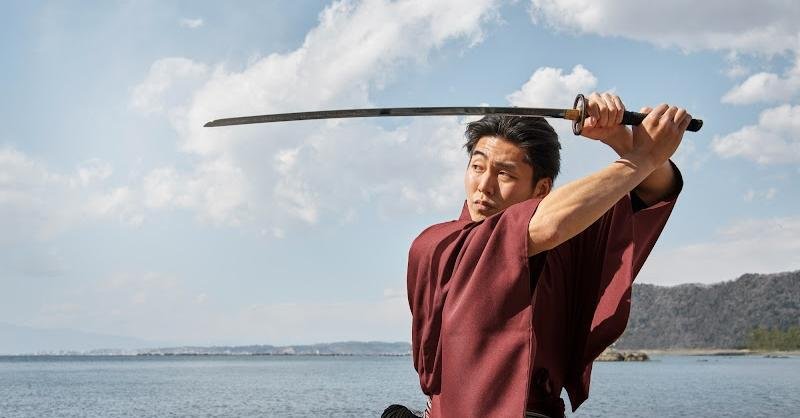Samurai swords, also known as katanas, have captivated the imagination of people around the world for centuries. These iconic weapons are not just tools of warfare but also works of art, embodying the rich history and culture of feudal Japan.
In this blog post, we’ll explore the distinctive features that set samurai swords apart from other blades and make them truly unique.
The Blade
The heart of any samurai sword is its blade, which is renowned for its exceptional quality and craftsmanship.
Curved Design
One of the most recognizable features of a samurai sword is its gracefully curved blade. This curvature, known as “sori,” is not just for aesthetics but serves a practical purpose. The curved shape allows for more efficient cutting and slashing motions, making the sword particularly effective in close combat situations.
Differential Hardening
A key aspect of the samurai sword’s blade is the differential hardening process, called “clay tempering” or “differential quenching.” This technique results in a blade with a hard, sharp cutting edge and a softer, more flexible spine. The famous wavy line along the blade, known as the “hamon,” is a visual representation of this hardening process.
High-Carbon Steel
Traditional samurai swords are crafted from high-carbon steel, often referred to as “tamahagane.” This steel is produced through a labor-intensive smelting process that removes impurities and creates a material with excellent strength and durability. The use of high-carbon steel contributes to the sword’s legendary sharpness and ability to hold an edge.
The Hilt
The hilt of a samurai sword is more than just a handle; it’s an integral part of the weapon’s design and functionality.
Tsuka (Handle)
The handle, or tsuka, is typically wrapped in ray skin (same) and then covered with silk or cotton cord wrapping (ito). This design provides a secure grip even in wet conditions. The wrapping pattern, known as tsukamaki, can vary and is often indicative of the sword’s style or the smith who created it.
Tsuba (Hand Guard)
The tsuba is the circular or sometimes square hand guard that separates the blade from the hilt. Often intricately decorated, tsuba serve both a practical purpose in protecting the wielder’s hands and an aesthetic one, showcasing the artistry of the swordsmith or a dedicated tsuba craftsman.
The Scabbard
The scabbard, or saya, of a samurai sword is not merely a protective sheath but an integral part of the sword’s overall design.
Lacquered Wood
Typically made from magnolia wood, the saya is often lacquered to protect it from moisture and wear. The lacquer can be plain or elaborately decorated, reflecting the status and taste of the sword’s owner.
Sageo (Cord)
A silk cord called sageo is attached to the scabbard. This cord serves both practical and decorative purposes, allowing the sword to be tied to the wearer’s armor or clothing and adding an element of visual appeal.
Craftsmanship and Tradition
What truly sets samurai swords apart is the level of craftsmanship and the rich traditions associated with their creation.
Forging Process
The forging of a samurai sword is a complex and time-consuming process that can take weeks or even months to complete. Master swordsmiths follow techniques that have been passed down through generations, combining traditional methods with modern metallurgical knowledge.
Spiritual Significance
In Japanese culture, the samurai sword is often considered to be more than just a weapon. It is believed to embody the spirit of the samurai who wielded it and is treated with great respect. Many swords are given names and are passed down as family heirlooms.
Modern Samurai Swords
While traditional samurai swords are historical artifacts, modern reproductions and functional swords inspired by these legendary blades continue to be produced.
Battle-Ready vs. Decorative
Modern samurai swords can be broadly categorised into battle-ready (functional) and decorative pieces. Battle-ready swords are crafted to withstand the rigors of cutting practice and martial arts demonstrations, while decorative swords are primarily for display purposes.
Materials and Construction
Contemporary swordsmiths may use modern steel alloys and production techniques while still adhering to traditional design principles. This allows for the creation of high-quality swords that combine historical aesthetics with improved durability and performance.
Conclusion
The samurai sword stands as a testament to the skill of Japanese swordsmiths and the rich martial tradition of feudal Japan. From its carefully curved and differentially hardened blade to its intricately designed hilt and scabbard, every aspect of a samurai sword is imbued with purpose and meaning.
Whether admired as a work of art or studied as a functional weapon, the samurai sword continues to fascinate and inspire people around the world.
For those interested in owning a piece of this legendary tradition, it’s crucial to research and purchase from reputable sources that respect the craftsmanship and cultural significance of these remarkable blades.
Whether you’re a martial arts practitioner, a history enthusiast, or simply an admirer of fine craftsmanship, the samurai sword offers a tangible connection to centuries of Japanese culture and martial prowess.










